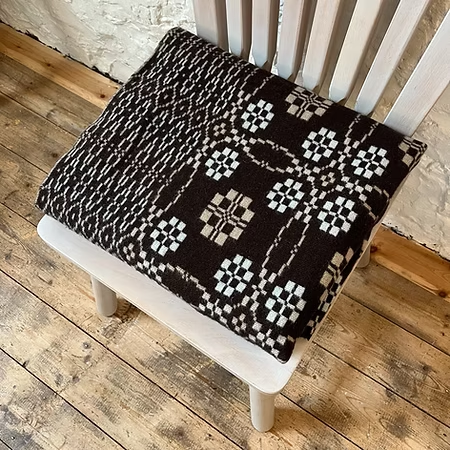
Discover handcrafted Welsh blankets from Dinefwr Blankets—woven from 100% wool and inspired by generations of Welsh weaving heritage. Explore our iconic patterns and bring home a piece of timeless craftsmanship.
Discover handcrafted Welsh blankets from Dinefwr Blankets—woven from 100% British wool and inspired by generations of Welsh weaving heritage. Explore our iconic patterns and bring home a piece of timeless craftsmanship.

Welsh blankets are world-renowned for their double-cloth & single cloth weave, bold geometric patterns, and simplified stripe patterns. At Dinefwr Blankets, we embrace this heritage while bringing new life to five iconic patterns.
A bold, symmetrical design known for its step-like “portcullis” motifs. This double-cloth, fully reversible blanket is a standout heirloom piece.
The Caernarfon Welsh blanket pattern is one of the most recognisable and traditional Welsh tapestry patterns. It originates from North Wales, particularly associated with the Caernarfon area, and is part of the rich tradition of Welsh double-weave blankets.
Design & Characteristics
The Caernarfon pattern features a bold geometric design, often described as a type of “portcullis” or stepped pattern. It is symmetrical and intricate, typically woven in a double-cloth construction, making the blankets reversible. The pattern is commonly seen in strong contrasting colours, such as black and white, red and black, or blue and cream.
Historical Origins
The earliest known examples of the Caernarfon pattern date back to at least the early 19th century, though its roots are likely older. Traditional Welsh weaving flourished in the 18th and 19th centuries, with many local mills producing these blankets. The pattern has been closely associated with the iconic Welsh woollen mills of North and Mid Wales.
Smaller, more compact motifs—like crosses and diamonds—bring elegance and symmetry.
These blankets are reversible, warm, and structurally complex.
The Penmachno Welsh blanket pattern is another traditional Welsh
tapestry design, originating from Penmachno, a village in North Wales.
Like other classic Welsh weaving patterns, it is part of the double-cloth
tradition, known for its durability, warmth, and intricate geometric designs.
Design & Characteristics
The Penmachno pattern features bold, structured motifs, often
incorporating a combination of squares, crosses, and stepped
elements. It has a slightly more compact and repeating geometric
layout compared to the Caernarfon pattern, though both share a
similar double-weave construction, making them fully reversible.
Historical Origins
The Penmachno pattern dates back to at least the 19th century,
though, like many Welsh patterns, its origins may be much older,
drawing inspiration from pre-industrial weaving traditions. Welsh
mills, particularly in North Wales, began producing double-weave
blankets in large numbers by the mid-to-late 19th century.
Penmachno, historically a wool-producing area, had small-scale
weavers before larger mills took over the production of Welsh
tapestry blankets. The pattern itself became popular in North and
Mid Wales, appearing in both blankets and tapestry bedcovers.
Our signature pattern. It blends geometric West Wales influences with softer edges and updated colourways. A beautiful fusion of old and new.
The Caernarfon Welsh blanket pattern is one of the most recognisable and traditional Welsh tapestry patterns. It originates from North Wales, particularly associated with the Caernarfon area, and is part of the rich tradition of Welsh double-weave blankets.
Design & Characteristics
The Caernarfon pattern features a bold geometric design, often described as a type of “portcullis” or stepped pattern. It is symmetrical and intricate, typically woven in a double-cloth construction, making the blankets reversible. The pattern is commonly seen in strong contrasting colours, such as black and white, red and black, or blue and cream.
Historical Origins
The earliest known examples of the Caernarfon pattern date back to at least the early 19th century, though its roots are likely older. Traditional Welsh weaving flourished in the 18th and 19th centuries, with many local mills producing these blankets. The pattern has been closely associated with the iconic Welsh woollen mills of North and Mid Wales.
Swansea Valley Striped Blanket:
Striking and practical, these striped woollen blankets are woven in a plain or twill weave—a simple, hardworking design once found in every Welsh home.
These blankets typically date back to the 19th and early 20th centuries, woven in the smaller mills scattered along the Swansea Valley — places like Ystalyfera, Pontardawe, and Clydach. They’re known for their simplicity, utility, and strong aesthetic charm.
Key Features:
Stripe Pattern: The defining feature is a broad striped design, usually running across the blanket’s width (sometimes length), often in deep reds, blues, mustards, greens, or natural wool shades. The stripes are usually bold and clear-cut, with some subtle variation in thickness.
Single Layer Weave: Unlike the doublecloth Caernarfon-style blankets, Swansea Valley striped blankets were often plain woven or twill woven — simpler to produce, but still very hard-wearing and warm.
Use and Style: These were everyday utility blankets, often used on beds, in farmhouses, or even as shawls or wraps. Some had hand-finished edges, and a few examples feature a blanket stitch or woven hem.
Cultural Notes:
They reflect a more understated and practical aesthetic compared to the ornate doublecloth designs.
Because of their simplicity, they’re now highly prized by collectors for their clean, minimal design and deep ties to local rural Welsh life.
Some people liken them in style to the traditional Carthenni from Carmarthenshire — but with that Swansea Valley colour signature.